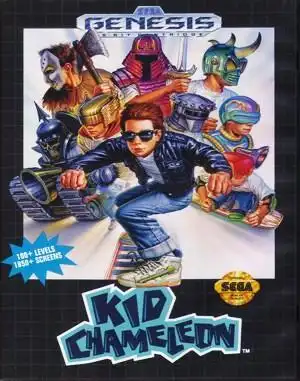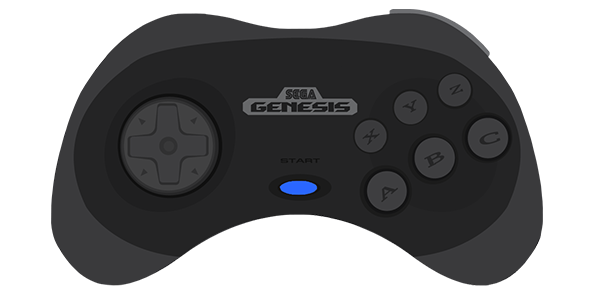Stepping into the shoes of Casey, the titular Kid Chameleon, felt like a rite of passage for many Sega Genesis owners back in the early '90s. This wasn't your average Saturday morning cartoon tie-in; it was a sprawling, tough-as-nails platformer where the main gimmick wasn't just cool, it was essential.
The premise? Simple and wonderfully bizarre. A new virtual reality arcade game called "Wild Side" pops up, and it's so good, players are getting trapped inside by the final boss, Heady Metal. Our hero, Casey, is the only one brave (or perhaps foolish) enough to jump in and beat the game from the inside to rescue everyone. What follows is a journey through over 100 levels of pure, unadulterated 16-bit challenge.
The Premise: Stepping into the Game
Forget saving princesses or collecting rings (well, you do collect diamonds, but that's different!). Kid Chameleon throws you straight into a digital world that feels like a bizarre, interconnected maze. You're navigating abstract landscapes, icy caverns, haunted houses, and even military bases, all seemingly stitched together by the logic of a mad AI.
The goal of each level is deceptively simple: reach the flag at the end. But teleporters can whisk you away to entirely different levels, sometimes taking you forward, sometimes back, creating a branching, non-linear path through its massive level count. It was a neat trick that added replayability, or perhaps just confusion, depending on your patience level.
More Than Just Jumping: The Power of Transformations
What truly set Kid Chameleon apart was its signature mechanic: the masks. Scattered throughout the levels, often hidden inside breakable blocks, were helmets that transformed Casey into one of nine distinct characters, each with unique abilities. Finding the right mask at the right time was key to progression and survival.
Remember these guys?
- Iron Head: Breaks blocks with his head. Simple, but effective.
- Berserker: A hulking tank that can charge through walls.
- Maniaxe: Throws axes, making ranged combat possible.
- Juggernaut: Rides a tank, offering powerful shots and defense.
- Micromax: Shrinks down to fit into small passages.
- Eyeclops: Climbs walls and sees hidden blocks.
- Red Stealth: A samurai with a double jump and sword.
- Cyclone: Turns into a tornado, allowing flight and attack.
- Skycutter: Rides a hoverboard, moving quickly and jumping far.
These transformations weren't just cosmetic; they changed your health bar, your movement, and how you interacted with the environment. Mastering when and where to use each one was the core puzzle of the game.
Navigating the Maze: Levels and Challenges
With over 100 levels advertised, Kid Chameleon felt huge. While many levels were short, linear sprints, others were complex affairs with hidden paths and teleporters. The sheer volume meant some environments and challenges could feel a bit repetitive, but the game did throw in curveballs like auto-scrolling sections to keep you on your toes.
But let's talk about the elephant in the room, or rather, the feature that wasn't in the room: a save system or passwords. In a game with over 100 levels and significant difficulty spikes, having to play through the entire thing in one sitting was brutal. This wasn't uncommon in early retro games, but for a game this long, it felt particularly punishing. Reaching a late level only to lose your last life was a real test of patience and controller durability.
The Retro Experience Today
Graphically, Kid Chameleon was decent for its time, though perhaps not the most vibrant Sega Genesis title. Environments could sometimes feel a bit bland, and enemies were often generic sprites. Casey himself was quite small on screen, though the transformations offered some fun visual variety. The music and sound effects were functional, providing the necessary retro bleeps and bloops without being particularly memorable standouts.
So, is it worth playing today? If you have a soft spot for challenging 2D platformers and appreciate unique mechanics, absolutely. The transformation system is still genuinely clever and fun to experiment with. The lack of a save system remains a significant hurdle for modern players used to checkpoints and quick saves, but approaching it as a true old-school arcade-style challenge can be rewarding.
Luckily, you don't need your old Genesis and a CRT TV (unless you want that authentic experience!). Kid Chameleon has been included in numerous Sega Genesis/Mega Drive collections over the years, available on modern consoles, PC (like the Sega Mega Drive and Genesis Classics on Steam), and even digital services like the Nintendo Switch Online + Expansion Pack. It's easier than ever to jump back into (and get trapped in) Heady Metal's world.
Is Kid Chameleon a Forgotten Gem or Just... Forgotten?
While it might not have the immediate name recognition of Sonic or Streets of Rage, Kid Chameleon holds a special place for those who tackled its demanding levels and experimented with its wild transformations. It was a product of its era – ambitious in scope, creative in its core mechanic, and frustratingly difficult thanks to the lack of modern conveniences.
It might not be a perfect game, and the lack of saving is a genuine pain point, but its unique premise and the sheer fun of morphing into different forms make it a memorable title in the Sega Genesis library. If you're looking for a deep dive back into the challenging world of 16-bit platforming, give Kid Chameleon another look. Just maybe clear your schedule first.
Frequently Asked Questions
Q: How many levels are in Kid Chameleon? A: The game features over 100 levels, though the exact number you see in one playthrough can vary due to teleporters and branching paths.
Q: Can you save your progress in Kid Chameleon? A: No, the original Sega Genesis version of Kid Chameleon does not have a save system or passwords. You have to complete the game in one sitting. Some modern collections might offer save state features, but the original game design did not include it.
Q: What makes Kid Chameleon unique? A: Its main unique feature is the ability to collect different masks that transform the player into characters with distinct abilities, essential for overcoming various obstacles and enemies.
Q: Is Kid Chameleon a difficult game? A: Yes, it is generally considered a difficult game due to challenging platforming sections, numerous enemies, and especially the lack of a save system requiring players to complete many levels without losing all their lives.


